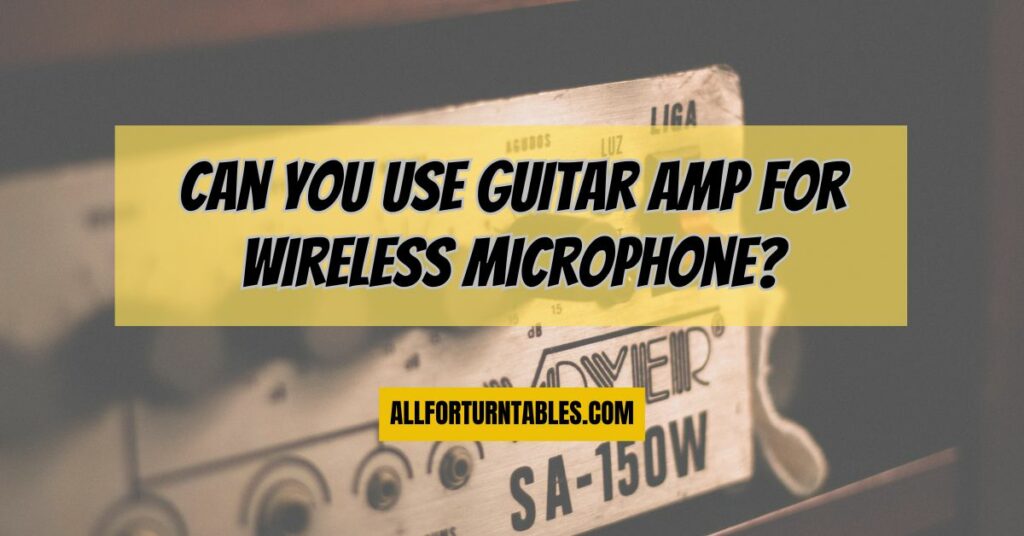Musicians and sound enthusiasts are often curious about creative ways to utilize their equipment, and one common question is whether a guitar amplifier can be used with a wireless microphone. While this setup might seem convenient, there are essential considerations to address. In this comprehensive guide, we will explore the possibilities and limitations of using a guitar amplifier with a wireless microphone, helping you make an informed decision for your audio needs.
Understanding Wireless Microphones
Before discussing their compatibility with guitar amplifiers, let’s briefly understand wireless microphones:
- Wireless Microphone Components: A wireless microphone system consists of a microphone transmitter, a receiver, and, optionally, a bodypack transmitter for instruments or lavalier microphones.
- Wireless Technology: Wireless microphones use radio frequency (RF) or digital technology to transmit audio signals wirelessly from the microphone to the receiver.
- Microphone Types: Wireless microphones come in various types, including handheld microphones, lavalier microphones, headset microphones, and instrument microphones, each designed for specific applications.
Using a Wireless Microphone with a Guitar Amp
Using a wireless microphone with a guitar amplifier is feasible but has several considerations:
- Impedance Matching: Guitar amplifiers are designed for electric guitars, which produce high-level instrument signals. Wireless microphones, on the other hand, generate mic-level signals. The impedance mismatch between the microphone and the amp can result in poor sound quality.
- Signal Matching: Wireless microphone systems have their own preamp and transmitter, which are optimized for microphone signals. Directly connecting a wireless microphone receiver to a guitar amp may lead to signal distortion and degradation.
- Feedback Risk: Using a guitar amp with a wireless microphone increases the risk of feedback, as the amp’s speaker may pick up and amplify the microphone’s output, creating a loop of sound.
Solutions for Using a Wireless Microphone with a Guitar Amp
While using a wireless microphone with a guitar amp may present challenges, there are solutions to address these issues:
- Direct Box (DI Box): A DI box can serve as an intermediary between the wireless microphone receiver and the guitar amp. It converts the microphone’s unbalanced signal into a balanced signal, addressing impedance and signal matching issues.
- Impedance Matching Transformer: Some DI boxes feature an impedance matching transformer designed specifically for microphone-to-guitar-amp connections.
- Ground Lift: Many DI boxes include a ground lift switch to address ground loop issues and reduce unwanted noise.
Considerations for Live Performances
In live performance situations, using a guitar amp with a wireless microphone may be a practical choice in specific scenarios:
- Artistic Effects: Musicians seeking creative sound shaping or unique effects may use a guitar amp to achieve a particular sonic character with their wireless microphone.
- Intimate Settings: In small venues or intimate performances, where feedback risks are manageable, a guitar amp can provide a distinct, characterful sound.
Alternatives for Microphone Amplification
For most professional applications, it is advisable to use dedicated microphone amplifiers or PA systems for amplifying wireless microphones. Here’s why:
- Optimal Sound Quality: Microphone amplifiers and PA systems are designed to handle microphone signals, ensuring the best sound quality and clarity.
- Feedback Control: These systems often include features like EQ, feedback suppression, and volume control, essential for a clean and balanced sound.
- Safety and Reliability: Using the right equipment reduces the risk of damaging your microphone or amp and ensures a safe and reliable audio setup.
In conclusion, while it is possible to use a guitar amplifier with a wireless microphone, it is not always the best choice due to impedance, signal matching, and feedback concerns. When using a wireless microphone in a professional setting, it is recommended to use a dedicated microphone amplifier or a PA system to achieve optimal sound quality and reliability. However, for specific creative sound-shaping purposes or in smaller performance settings where feedback risks can be managed, using a guitar amp with the assistance of a DI box can be a viable option. Remember that each setup has its challenges and limitations, so it’s crucial to weigh your options carefully based on your specific audio needs and preferences.


